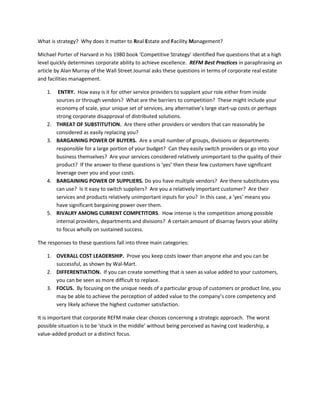
120203.Ifma Article
- 1. What is strategy? Why does it matter to Real Estate and Facility Management? Michael Porter of Harvard in his 1980 book ‘Competitive Strategy’ identified five questions that at a high level quickly determines corporate ability to achieve excellence. REFM Best Practices in paraphrasing an article by Alan Murray of the Wall Street Journal asks these questions in terms of corporate real estate and facilities management. 1. ENTRY. How easy is it for other service providers to supplant your role either from inside sources or through vendors? What are the barriers to competition? These might include your economy of scale, your unique set of services, any alternative’s large start-up costs or perhaps strong corporate disapproval of distributed solutions. 2. THREAT OF SUBSTITUTION. Are there other providers or vendors that can reasonably be considered as easily replacing you? 3. BARGAINING POWER OF BUYERS. Are a small number of groups, divisions or departments responsible for a large portion of your budget? Can they easily switch providers or go into your business themselves? Are your services considered relatively unimportant to the quality of their product? If the answer to these questions is ‘yes’ then these few customers have significant leverage over you and your costs. 4. BARGAINING POWER OF SUPPLIERS. Do you have multiple vendors? Are there substitutes you can use? Is it easy to switch suppliers? Are you a relatively important customer? Are their services and products relatively unimportant inputs for you? In this case, a ‘yes’ means you have significant bargaining power over them. 5. RIVALRY AMONG CURRENT COMPETITORS. How intense is the competition among possible internal providers, departments and divisions? A certain amount of disarray favors your ability to focus wholly on sustained success. The responses to these questions fall into three main categories: 1. OVERALL COST LEADERSHIP. Prove you keep costs lower than anyone else and you can be successful, as shown by Wal-Mart. 2. DIFFERENTIATION. If you can create something that is seen as value added to your customers, you can be seen as more difficult to replace. 3. FOCUS. By focusing on the unique needs of a particular group of customers or product line, you may be able to achieve the perception of added value to the company’s core competency and very likely achieve the highest customer satisfaction. It is important that corporate REFM make clear choices concerning a strategic approach. The worst possible situation is to be ‘stuck in the middle’ without being perceived as having cost leadership, a value-added product or a distinct focus.